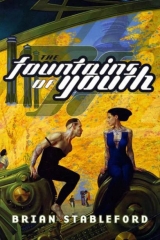
Текст книги "The Fountains of Youth"
Автор книги: Brian Stableford
Жанр:
Космическая фантастика
сообщить о нарушении
Текущая страница: 22 (всего у книги 27 страниц)
SIXTY-FOUR
I had maintained my correspondence with Emily Marchant despite the restrictions placed upon it by the time delay. I sent her a long oration lamenting the unsympathetic reception of The Last Judgmenteven though I knew that she would align herself with my detractors. It might have been more pleasant to speak of other matters, but ever since Julius Ngomi had appeared in the unlikely role of agent provocateur I had been very careful not to mention the planet Jupiter, and since marrying into the Continental Engineers I didn’t want to get involved in heavy discussions of cutting-edge gantzing technics. I had become rather anxious that my private correspondence might get hijacked, if not by eavesdroppers then by my nearest and supposedly dearest.
Fortunately, by the time that Emily formulated her reply to my message, she had more important things to discuss than the alleged futility of my mission. Hot on the heels of the Hope’sdiscovery of Ararat came the discovery by Vishnu, a silver-piloted kalpa probe launched in 2827, of an “Earthlike” world orbiting a G-type star in Scorpio. Like Ararat, this planet’s elaborate ecosphere had produced animal species analogous to all the major groups of Earthly animals, including two that seemed to be on the verge of true intelligence.
The new world, called Maya by the silver’s masters, seemed no more inviting to would-be colonists than Ararat, but it caused a great deal more excitement. Hopewas widely considered within the Oikumene to be a direly unsatisfactory platform for colonization, partly by virtue of its antiquity and partly by virtue of the catalog of mistakes and hesitations dutifully recorded by the Ark’s transmissions. Maya, having been found by machines, awaited the careful attention of a colonization mission planned by thirtieth-century sophisticates and executed with the aid of the full panoply of modern technology.
The only question to be answered was whichgroup of thirtieth-century sophisticates would be entrusted with the task.
Had I thought more deeply about the matter, I might have anticipated the chaos that would ensue, but I was too busy. It was not until Emily’s message arrived that I realized that a serious conflict of interest had arrived in the system even sooner than Julius Ngomi’s colleagues and collaborators had expected.
“The race is on,” Emily told me, speaking from one of her favorite VEs, which set her against a vertiginous background of ice mountains. “By the time the Hardinists had got around to sending out invitations to their conference it was way too late. The fabers weren’t about to give away their head start, so your old friend Khan Mirafzal is already diverting his microworld’s course Scorpioward. The Oort Halo crowd reckon that they can still overtake him if they take direct aim, and the New Ark people figure that even if they can’t quite get there firstest they can still land the mostest men and the bes test equipment. Two other faberweb micro worlds are negotiating with Mirafzal for a planned rendezvous, a pooling of effort and a piece of the action, but they haven’t got near a decision as to whether they ought to reengineer children with legs in order to get a foothold on the planet, or whether they ought to content themselves with setting up an orbital network to work hand-in-hand with the Oort gang, the New Arkers, or both.
“The kalpa programmers are crying foul left, right, and center. Earth’s high-and-mighty will back their claims of ownership right down the line, of course, but they must know that their proclamations won’t mean a thing thirty-nine light years away. The Gaean Libs will probably want the whole process stopped, of course, but that’s just hot air. The real fight will be to determine the methods and objectives of the land grab, and no one thinks that there’s the least chance of settling that in advance. No matter who wins the race, the competition will only intensify once the drops get under way. If the New Arkers were united among themselves they’d have a slim chance of putting a few controls in place, but they’ve always been a loose coalition of interested parties with no meaningful ideological center. In order to get their ship ready in time they’ll have to offer berths to every faction that can help, including the Cyborganizers. The likelihood is that they’ll fragment as soon as they arrive. If you think that Hope’sbotches added up to a fiasco, you ain’t seen nothing yet.
“Even you’ll have to admit now that everything’s changed, Morty. Earth isn’t the game board any more. The Hardinist case for its careful preservation as the footsloggers’ ultimate refuge has gone right out the window. The galaxy hasto be full of worlds like Ararat and Maya. Terra-formable ecospheres mustbe a dime a dozen. The only mystery is the Fermi paradox. If we’re here, where the hell are all the others? You’re a historian, Morty—you know how hard we tried to obliterate ourselves, and stillwe made it. The others have to be here too, even if we can’t tune into their beacons, and it’s only a matter of time before we run into them. After that… everything will change again, and nobody can guess exactly how.”
She had much more to say, of course, but that was the red meat. The race was on, and after the race would come the conflict, and after the conflict… the ecocatastrophes and the wars?
I didn’t even recognize the names of some of the factions to which Emily referred so casually. I knew that there were people in the Oort Halo, but I had no idea that they constituted a “crowd” or what their gang mentality might be. I had only the vaguest notion about the composition of the New Arkers and had previously thought of them as merely one more set of eccentrics intent on hollowing out asteroids to make microworlds. I did, however, have some inkling of what Cyborganizers were, by virtue of living with Tricia Ecosura. She often mentioned them, sometimes critically and sometimes sympathetically, but always giving the impression that they were a coming thing, as revolutionary in their own fashion as the newly rampant Continental Engineers.
Under different circumstances, I might have asked Emily to give me a much more detailed account of what she thought the various Maya-bound factions were up to, but it didn’t seem politic. For one thing, I felt that Julius Ngomi was sure to be listening in, and I didn’t want to be his mule. For another, I had to concentrate on the two tasks I now had on hand where there had previously been only one.
I could have taken time out from my history to think about the farthest horizons of the expanding Oikumene, had it not been for the fact that any such time was already spoken for, but I had already agreed to dedicate any and all such time to Lua Tawana, who was growing up quickly. For that reason, I let the matter slide. My reply to Emily’s dispatch acknowledged what she had said but did not engage with it in any intellectually serious fashion. Having not yet parented a child of her own, she probably did not understand, but she made allowances anyhow.
For me, she always did make allowances—and this time, I felt fully entitled to claim them. I was, after all, a man with parental responsibilities.
PART FIVE Responsibility
The triumph of Earthbound humanity is that individual people are still so stubbornly different from one another. Half a millennium of universal emortality has not eroded, let alone erased, the variety of human personality. Instead, our longevity has allowed us to hone and refine our individuality to an exactitude that our remote ancestors would have found astonishing. The Thanaticists were only half right when they claimed that this process of refinement was the work of Sculptor Death, only made possible by the sacrifice of alternative pathways in the brain, just as the Cyborganizers are only half right when they claim that we cannot evolve any further unless we open up new neural pathways for which natural selection has made no provision. The truth is that the natural process of growing older, no matter how long it might be protracted, cannot and does not involve the elimination of the elasticity of human thought and human possibility. The process of further human evolution must, in essence, be an extrapolation of our innate resources, no matter how cleverly and elaborately they are augmented by external technology.
However conducive it might be to Utopian ease and calm, it would not be good for humankind if we were ever to become so similar to one another that it became impossible for people to think one another mad or seriously misguided. Although those extremists who decide to die after a mere seventy or eighty years seem bizarre to sensible moderates, while those who only want to live forever do not, even emortals have to come to terms with the fact that death isinevitable. No matter how hard we may pretend that true emortality has turned wheninto if, the fact remains that we are not immortal. In time, the sun will die; in time, the universe itself will fade into dark oblivion; even the Type-4 speculators who assure us that the extinction of our own inflationary domain will not prevent our remotest descendants from seeking new opportunities in the Unobservable Beyond are only speaking in terms of postponement. At heart, we are all Thanaticists in the sense that everyone who is not rudely seized by predatory death must ultimately make his own compact with the ultimate enemy—and we are all Cyborganizers in the sense that everyone must decide exactly which augmentary technologies he will deploy within the terms of that compact.
–Mortimer Gray
Part Ten of The History of Death
SIXTY-FIVE
Lua Tawana was the linchpin of my world for more than twenty years, and she remained its most significant anchorage long after that. I had not given the matter much consideration before, but as soon as she learned to speak, the logic of the situation became clear. Everyone has a multiplicity of parents, but very few of the Earthbound foster more than one child. Child rearing is the only emotional luxury so strictly rationed on Earth that it is bound to seem like a once-in-a-lifetime opportunity even to people who hope to live for millennia. It is hardly surprising that emortal parents become obsessed with the mental development their children—even parents who have decided to maintain the momentum of their careers throughout the years of parenthood.
No matter how clearly focused one becomes during a child-rearing marriage, however, other things do intrude. It was easy enough for me to relegate from immediate concern the developments in and beyond the outer solar system that Emily Marchant was so keen to bring to my attention, but it was not so easy to ignore matters occupying the attention of my marriage partners. I tried hard, and I have no doubt that they tried equally hard, but certain things intruded in spite of all our best efforts, and one of them was Tricia’s increasing involvement in the 2920s with the Cyborganizers. I think I might have held myself aloof even from that had it not been for an unfortunate stroke of coincidence, but I have always been a trifle accident-prone and that was one vulnerability that did not depart as I attained the age of reason and responsibility.
At the most elementary level, the Cyborganizers were merely the newest generation of apologists for cyborgization. They adopted a new title purely in order to make themselves seem more original than they were. In fact, there had always been such apologists around, but the increasing use of cyborgization in adapting people to live and work in space and the hostile environments of other worlds within the solar system had given new ammunition to those who felt that similar opportunities ought to be more widely explored on Earth.
The progress of the “new” movement followed a pattern that had now become familiar to all serious historians if not to the present-obsessed media audience. All the old controversies regarding “brain-feed” equipment surfaced yet again, refreshed by controversy, and all the old tales about wondrous technologies secretly buried by the world’s paternalistic masters began to do the rounds, neatly varnished with a superficial gloss of modernity. TV current-affairs shows initially treated the propaganda flow with amused contempt, but as the stream built toward a tide the casters began to feed off it more extravagantly, and hence to feed it, thus accelerating its ascent to fashionability.
The gist of the the Cyborganizers’ argument was that the world had become so besotted with the achievements of genetic engineers that people had become blind to all kinds of other possibilities which lay beyond the scope of DNA manipulation. They insisted that it was high time to reawaken such interests and that recent technical advances made in the field of functional cyborgization should be redeployed in the service of aesthetic cyborgazation. There was much talk of “lifestyle cyborganization.” The introduction into the latter term of the extra two letters did nothing to transform its real meaning but contrived nevertheless to generate a host of new implications. The Cyborganizers were, of course, very anxious to stress that there was all the difference in the world between cyborganization and robotization, the former being entirely virtuous while the latter remained the great bugbear of emortal humankind.
I would have been perfectly content to ignore the Cyborganizers had they only been content to ignore me. I am reasonably certain that they would have done exactly that if Tricia Ecosura had not agreed to meet face-to-face with Samuel Wheatstone, one of the movement’s most enthusiastic propagandists, while he was visiting Neyu in 2924. Even that occasion might have passed off harmlessly had I only had the good sense to stay out of the way—as I certainly would have done if I had known that Samuel Wheatstone had not always been content to wear the name his parents had given him. Because I had not, there seemed to be no harm at all in accepting Tricia’s invitation to take a stroll on the beach behind our hometree and say hello to her guest.
She had obviously mentioned me to him—why should she not?—and he was fully prepared to take delight in my confusion. I did not recognize his face, of course, because it had been so radically transformed by cyborgization. His eyes were artificial and his skull was elaborately embellished with other accessories—most of them, I presumed, ornamental rather than functional.
“It’s a great honor to meet you in the flesh at last, Mortimer,” he said to me, beaming broadly. “I’ve never forgotten our discussion, although I’ve not kept up with your work as assiduously as I should have.”
While I was still trying to work out the import of this greeting, Tricia said: “You didn’t tell me that you and Morty knew one another, Samuel.”
“I wanted it to be a surprise,” he said. “I was using a different name when we last encountered one another. I fear that Mortimer still has no idea who I am—but it was two hundred years ago, and although our contest was transmitted in real time the space we shared was virtual.”
“You’re Hellward Lucifer Nyxson?” I guessed, tentatively.
“I was,” he admitted, blithely. “A youthful folly. It seemed inappropriate to retain the name once the heart had gone out of Thanaticism, so I reverted to my former signature.”
“Of course you did,” I countered, bitterly. “After all, you wouldn’t want the reputation of your present insanity to be tainted by the legacy of past insanities, would you?”
His smile grew broader still. “That’s it!” he said, feigning pleasure. “That’s exactly the expression I remember. I thought you might have forgiven me—after all, I did make you a lot of money—but I’m delighted to find that you haven’t. Principled adversaries are somuch more interesting and rewarding than cynical fellow travelers, don’t you think?”
“Aren’t you supposed to be dead?” I asked him, packing as much sarcasm into my tone as I could. “Common decency surely required you to join the martyrs you inspired?”
“Don’t be so stubbornly literal, Mortimer,” he said. “You know full well that I was only trying to stir things up.I’m a showman, not a suicidal maniac. It’s what I do. You should try it some time. It’s fun.” For one eerie moment he sounded exactly like Sharane Fereday—and I reacted almost as if he were.
“Fun!”I echoed, with bitter contempt. “You should be in some antique SusAn chamber along with all the other murderous bastards—human litter that dare not speak its name.”
“You stole that,” he charged, with deadly accuracy. “That’s one of dear old Julius’s catchphrases. That’s the wonderful thing about Earth-bound humanity, don’t you think? There might be billions of us, but we’ll all be around long enough for everybody who’s anybody to meet everybody who’s anybody else. You ought to be careful about repeating other people’s bon mots, though. That way lies robotization. I worry about that, as you’ll doubtless remember—but I worry far more about people like you than people like me.”
“I don’t want you to worry about me,” I said, coldly. “I think I’ll go back inside now. I have better things to do than talk to you.”
“But I doworry about you, Mortimer,” Wheatstone/Nyxson assured me, refusing to consent to the end of the conversation. “I gave you an audience, and you frittered it away. I gave you a cause, and you fumbled the ball. You never have been able to make up your mind about the issues I raised, have you? I put you on the map, but you meekly removed yourself again because you didn’t know exactly where you wanted to be located. It was Mare Moscoviense you ran away to, wasn’t it? You probably came to Neyu because you expected it to be a similarly stagnant backwater—but I’m surprised you didn’t move on as soon as Mica and her friends told you that they intended to make it the central crossroads of a new continent. Do you really think your ideas, motives, and actions are those of a man who’s ready to live forever, Mortimer?”
I had to grit my teeth for a moment lest a reflexive tremble set them chattering. “You gave me nothing,” I told him, when I was sure that I could frame the words properly. “I found my own cause and my own audience long before I heard your stupid pseudonym, and I’m still on the only map that matters. Within a hundred years I’ll have finished my history, and it will be definitive. It will be good.It will command attention because it’s important, not because I once got sucked into a moronic publicity stunt by a man who doesn’t know the meaning of the word conscience.You’re notimportant. You’re just a clown, an exhibitionist, a fool.If you’re behind the Cyborganizers, they’re even more intellectually derelict than I thought. I’m astonished that anyone as intelligent as Tricia should even have condescended to talk to you. I won’t.”
I turned my back then, absolutely determined to go—but Hellward Lucifer Nyxson was never a man to concede the last word.
“You’re beautiful, Mortimer,” he called after me. “A pearl beyond price. I’d forgotten just how precious you are—but thanks for reminding me. Tricia’s a very lucky woman, to have you as a co-parent.”
SIXTY-SIX
I ignored it all, of course. I rose above it and put it behind me, for all of seven days. When Tricia accused me of being rude to her guest I refused to rise to the challenge. When Lua asked me why Mama Tricia was angry with me I claimed that I didn’t know.
Unfortunately, seven days was all the time it required for the Cyborganizers to launch an all-out media attack on The History of Death, selecting it out as a “typical example of modern academic research,” guilty of “de-historicizing” cyborgization.
The commentary I had provided to the The Last Judgmentactually contained only three brief references to early experiments in cyborgization, but none of them were complimentary and they swiftly became the Cyborganizers’ favorite example of the “sketchily caricaturish” attitude to cyborgization fostered by the world’s “Secret Masters.” Like all of my kind, the Cyborganizers alleged, I was in the pocket of the Hardinist Cabal. I was producing bad history, warped to the service of their hidden agenda, deliberately falsifying the past so as to to make it seem that organic-inorganic integration and symbiosis were peripheral to the story of human progress rather than its very heart.
It was the most blatant nonsense imaginable, but it emerged into the media marketplace at a time when anything connected to the cause of Cyborgization was newsworthy, and it became news.
If I had any defense to offer, Samuel Wheatstone ringingly declared to the world, he would be only too pleased to debate the matter in public.
I could not refuse the challenge, not because it would have seemed cowardly but because it would have been seen by the public at large as a tacit confession that I was a bad historian.
I didn’t want to rush into anything without preparing my ground, but time was of the essence. I had to find out what the Cyborganizers were all about in a tearing hurry, and to do that I had to wheedle my way back into Tricia’s good books. I shamelessly exploited the fact that the twelve-year-old Lua was genuinely distressed by our estrangement, and I managed to avoid getting sidetracked into mere technical discussion by including Lua in our educational discussions.
“The problem,” Tricia explained, pretending to talk to Lua as well as to me, “is that the earliest adventures in human-machine hybridization were carried out at a time when nobody had any real idea of what might be practical and what wouldn’t. Their mistakes generated a lot of bad publicity. It was a time when IT still stood for information technology, because there was no nanotech to produce internal technology. There were no sloths, let alone silvers, but the computers of the day were getting faster and faster, juggling what seemed to their users to be huge amounts of data. It seemed only natural to think of building bridges between the brain and clever machinery, so there was a lot of talk about memory boxes and psychedelic synthesizers. People who actually went so far as to build connection systems into their heads were regarded as madmen, or even criminalized, but that only made them seem more heroic to their supporters. They couldn’t know that the things they were trying to do were much more difficult than they thought.”
“Some of them were,” I agreed. “But we don’t make fun of the idea of slotting additional inorganic memory stores into the brain because it’s impossible, but because it no longer seems as necessary to us as it did to people whose so-called rejuvenation technologies tended to disrupt and diminish their existing memories. We don’t laugh at the idea of psychedelic synthesizers because they didn’t work—they just seem like absurdly blunt instruments now that we have a much better understanding of brain chemistry and a sophisticated VE technology that can produce the same sort of rewards with infinitely less risk. Anyway, the real problem was that one or two of the things the brainfeed brigade were trying to do turned out to be much easierto accomplish than their opponents thought.”
“What do you mean?” Lua asked, obligingly.
“I mean that one of the technologies that the world’s not-so-secret masters really did decide to put away for the general good was a device that really did turn human beings into robots, at least temporarily.”
“That’s not fair,” Tricia said, presumably echoing the views of Samuel Wheatstone. “If the so-called Medusa device hadn’t made its debut as a murder weapon, employed by the world’s last and most flamboyant serial killer, it wouldn’t have seemed anywhere near as demonic as it did. That whole line of technical enquiry was strangled at birth, without any regard to beneficial uses or useful applications. Like the IT versions of VE tech, it was labeled dangerous and shoved into SusAn with all the other criminals that the Hardinist Tyranny didn’t want to deal with. In a world that had an authentically democratic government instead of a gang of bureaucrats dancing to the tune of a gang of pirates who seized economic control of the ecosphere way back in the twenty-first century, that kind of thing couldn’t happen. The people in the outer system won’t tolerate that kind of intellectual repression, so why should we put up with it here on Earth?”
“IT isn’t the only acronym to have changed its meaning since the twenty-first century,” I pointed out. “You used VE just now to mean Virtual Experience, but it’s not so long ago that it was only used to mean Virtual Environment. We’d still be using it in the narrower way if the techniques hadn’t taken aboard certain features of the supposedly suppressed technologies you’re using as key examples. The harmless and beneficial applications of IT-based VE and the so-called Medusa device havebeen integrated into the way we live, having been redirected into orthodox channels. The idea that whole areas of research have been suspended and deep-frozen is nonsensical—it’s a myth.”
Tricia wouldn’t admit it, of course, but I felt that I could at least hold my own on that particular battleground—and I therefore assumed that Wheatstone would choose another. I knew that I had to expect the unexpected, but I tried as best I could to put myself in his shoes, hoping to anticipate his line of attack far more accurately than I had when we had crossed swords publicly before. It seemed to me, when I did this, that there was one line of Cyborganizer rhetoric to which I might be particularly vulnerable.
The Cyborganizers were skeptical of the claim that Zaman transformations guaranteed true emortality. Although the oldest true emortals had now beaten the previous records set by false emortals, and showed no obvious sign of being unable to extend their lives indefinitely, the Cyborganizers insisted that what was presently called “emortality” would eventually prove wanting. They conceded that Zaman transformations had dramatically increased the human life span but insisted that some kinds of aging processes—particularly those linked to DNA copying-errors—were still effective. Eventually, they claimed, people would again begin to die of “age-related causes.” Even if it took thousands of years, and even if they avoided the perils of robotization, true emortals would begin to fade away—and in the meantime, they would remain vulnerable to all manner of accidents.
In the great tradition of preachers, the Cyborganizers played upon emortal fears only to stoke up demand for a new kind of hope. They wanted to resurrect the term that emortality had made obsolete: immortality. In order to turn flawed emortality into authentic immortality, the Cyborganizers claimed, it would be necessary to look to a combination of organic and inorganic technologies. The deepest need of contemporary humankind, they said, was not more of the same precarious kind of life, but a guaranteed “afterlife.”
What they meant by “afterlife” was not, of course, what their religious predecessors had meant, but some kind of transcription of the personality into a new matrix that would combine the best features of inorganic and organic chemistry.
“All this is old stuff too,” I told Tricia, by way of practice. “It’s the old chestnut about uploading one’s mind to a computer, given a new lick of paint and a bit of fancy dress. The mind isn’t a kind of ghost that can simply be moved out of one body into another. Our bodies areour selves. The mind is a condition of the whole, not an inhabitant of the part. It’s so easy nowadays to design a silver that can replicate the speech patterns and responses of a particular person that we all use them to answer our phones, and the best ones can pass for their models in polite society almost indefinitely—but none of us is idiot enough to believe that his answering machine is another version of himself. No one thinks that the fact that his silver will carry on answering his phone after he’s dead means that he’ll really still be alive.”
“That’s exactly what Samuel means by a sketchy caricature,”Tricia told me. “We’re much more sophisticated than the old advocates of uploading. We’retalking about gradual personal evolution, not abrupt metamorphosis. We’re talking about the evolution of the body beyond genetically specified limits. We’re talking about the expansion of the self.Fabers and their kin are already redefining their own selfhood by altering their physical makeup, and they already know that however clever genetic engineers might become in adapting men for life in microworlds or within the ecospheres of Earthlike planets, only cyborgization can create entities capable of working in genuinely extreme environments. We’re already doing it. Everybody with IT is already a cyborg, and everybody in the outer system is perfectly at home with the idea that the time has come to let IT expand into ET– external technology.
“It’s becausethe mind is a condition of the whole and not an inhabitant of the part that we’re already engaged in a process of machine-enhanced mental evolution. That’s the very essence of cyborganization, and the only reason you can’t see it, Morty, is that you’re stuck in the past, refusing to accept release from the prison oí frail flesh.The day will come when you want to live in the future, Morty—and that’s when you’ll have to accept that the only way to avoid becoming a robotically petrified mind in a slowly decaying body is to evolve”








